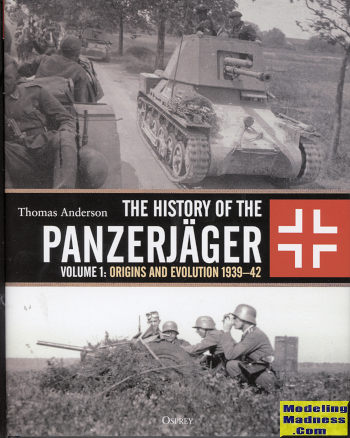 Osprey
continues with its volumes on the German Army with this first volume on the
Panzerjäger. These were basically the German anti-tank units. Many of us are
aware that a lot more tanks were destroyed by anti-tank methods rather than by
other tanks, though tank on tank battles are more interesting.
Osprey
continues with its volumes on the German Army with this first volume on the
Panzerjäger. These were basically the German anti-tank units. Many of us are
aware that a lot more tanks were destroyed by anti-tank methods rather than by
other tanks, though tank on tank battles are more interesting.
Not surprisingly, efforts to defeat enemy tanks have
their roots back in mid-WWI when the British introduced the weapon to the
battlefield. Initially they seemed unstoppable, but it was discovered that
artillery and high powered rifles could penetrate the rather thin armor of early
tanks.
It was the time between the wars that these weapons
really took off. At first anti-tank rifles were the way to go. Indeed, with
armor thicknesses of 15mm or less, a long barreled, high-power rifle was more
than sufficient. However, it took a dedicated anti-tank cannon to really defeat
the tank. All the major nations developed guns in the 20-45mm range and all were
effective. Sticking with the German army's Panzerjäger units, it was the
much-copied 37mm anti-tank gun that led the way. It was highly successful in the
Spanish Civil War where it made quick work of Republican and Soviet tanks.
However going into WWII, it was realized that it was not enough for the more
heavily armored British and French tanks.
Thus began a continuing period of ever more effective
anti-tank weaponry. As the German Army's opponents increased the armor on their
tanks, even more powerful guns had to be developed. Since the battlefield was a
lot of flowing movement, it was discovered that attaching an anti-tank gun to an
obsolescent tank chassis or on a half track would provide even greater freedom
of movement. With standard anti-tank artillery, once the enemy found it, the
existence of the gun and crew would be limited. it was also discovered that the
flat trajectory of anti-aircraft artillery made for a great, though easily
spotted anti-tank gun and the reputation of the fearsome German '88' was born.
In this volume, the author has really done a superb job
of research, going through archives and other primary sources to tell the story
of the development and growth of the Panzerjäger units. This includes the ever
changing organization of these units. Such is the scope of the subject that,
like some of his other similar books, there is too much for one volume. This
volume covers up until mid-war and provides a plethora of great period photos as
well as action reports and experiences of those involved in the fighting.
The end result is a superb reference book and a great
read to boot. This is the sort of book that will appeal to the history buff as
modeler alike. As such, I give it my highest recommendation. You won't be
disappointed.
July 2018
For more on the complete line of Osprey books,
visit
www.ospreypublishing.com.
If you would like your product reviewed fairly and fairly quickly, please
contact
me or see other details in the Note to
Contributors.
 Osprey
continues with its volumes on the German Army with this first volume on the
Panzerjäger. These were basically the German anti-tank units. Many of us are
aware that a lot more tanks were destroyed by anti-tank methods rather than by
other tanks, though tank on tank battles are more interesting.
Osprey
continues with its volumes on the German Army with this first volume on the
Panzerjäger. These were basically the German anti-tank units. Many of us are
aware that a lot more tanks were destroyed by anti-tank methods rather than by
other tanks, though tank on tank battles are more interesting.